Integrated Project Delivery: Malaysian Construction Case Study Report
VerifiedAdded on 2021/05/27
|20
|4165
|121
Report
AI Summary
This report provides a comprehensive analysis of Integrated Project Delivery (IPD) within the context of the Malaysian construction industry, using the Maxis Tower project as a case study. It begins with an introduction to IPD, outlining its core principles, benefits, and theoretical underpinnings, followed by a detailed case study outline, including business conditions, stakeholder analysis, and organizational structure. The report then delves into the key objectives of IPD for the case study, focusing on waste reduction and cost-effectiveness. It presents the IPD strategy, covering management plans, procurement processes, contracts, and IT support infrastructure. The report concludes with an evaluation of the IPD strategy, discussing potential bottlenecks, barriers, and challenges, providing a holistic view of IPD implementation and its impact on construction projects in Malaysia. The report also includes figures to visually represent the IPD strategy, management, and IT infrastructure.
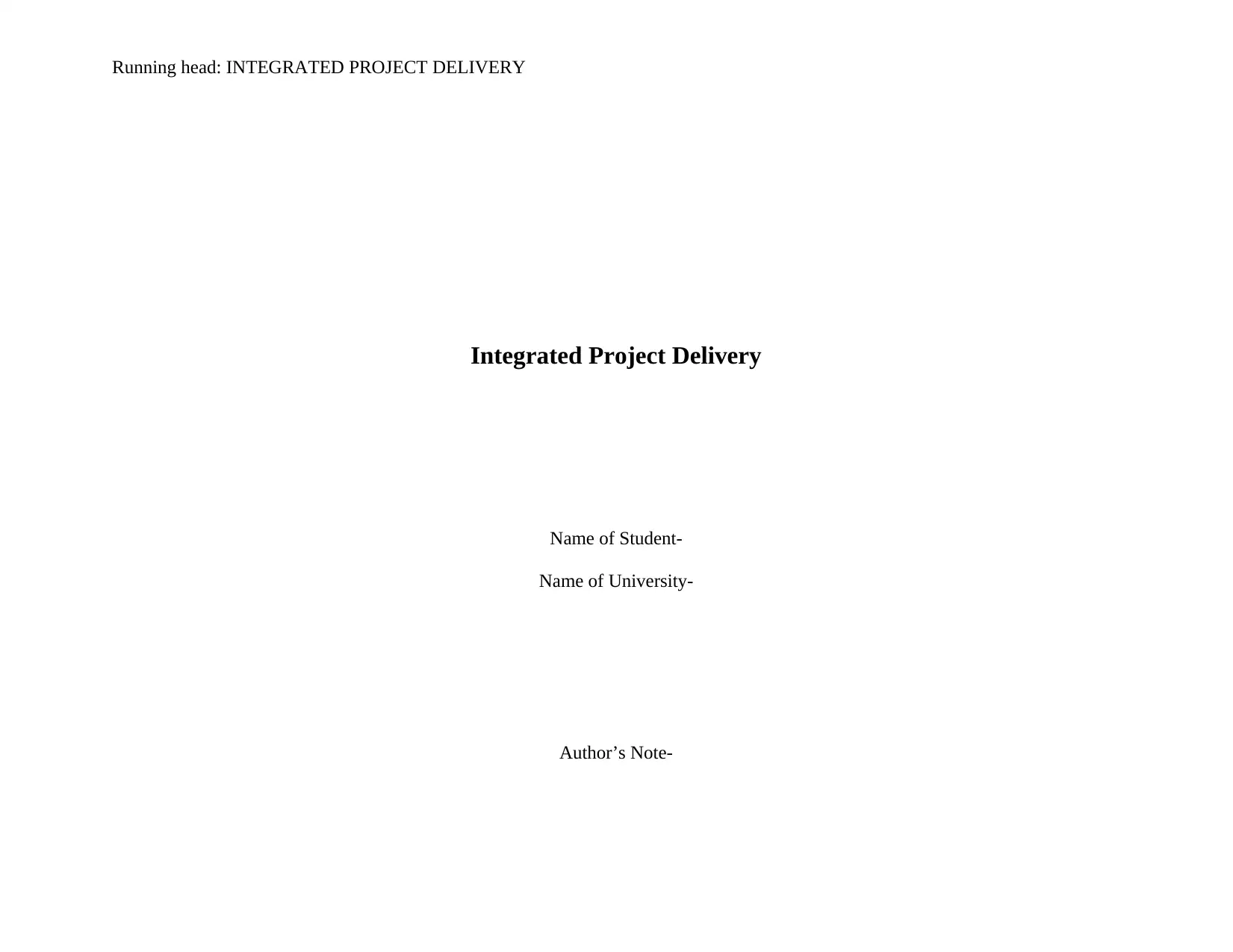
Running head: INTEGRATED PROJECT DELIVERY
Integrated Project Delivery
Name of Student-
Name of University-
Author’s Note-
Integrated Project Delivery
Name of Student-
Name of University-
Author’s Note-
Paraphrase This Document
Need a fresh take? Get an instant paraphrase of this document with our AI Paraphraser

1INTEGRATED PROJECT DELIVERY
Table of Contents
1. Introduction......................................................................................................................2
2. Integrated Project Delivery theory/literature...................................................................3
3. Case Study Outline..........................................................................................................5
4. Key Objectives of IPD for the Case................................................................................7
5. IPD strategy.....................................................................................................................8
5.1 Strategy Introduction.................................................................................................8
5.2 IPD Management Plan...............................................................................................8
5.3 IT support infrastructure..........................................................................................10
6. Evaluation of Strategy...................................................................................................13
7. Conclusion.....................................................................................................................14
8. References......................................................................................................................15
Table of Contents
1. Introduction......................................................................................................................2
2. Integrated Project Delivery theory/literature...................................................................3
3. Case Study Outline..........................................................................................................5
4. Key Objectives of IPD for the Case................................................................................7
5. IPD strategy.....................................................................................................................8
5.1 Strategy Introduction.................................................................................................8
5.2 IPD Management Plan...............................................................................................8
5.3 IT support infrastructure..........................................................................................10
6. Evaluation of Strategy...................................................................................................13
7. Conclusion.....................................................................................................................14
8. References......................................................................................................................15
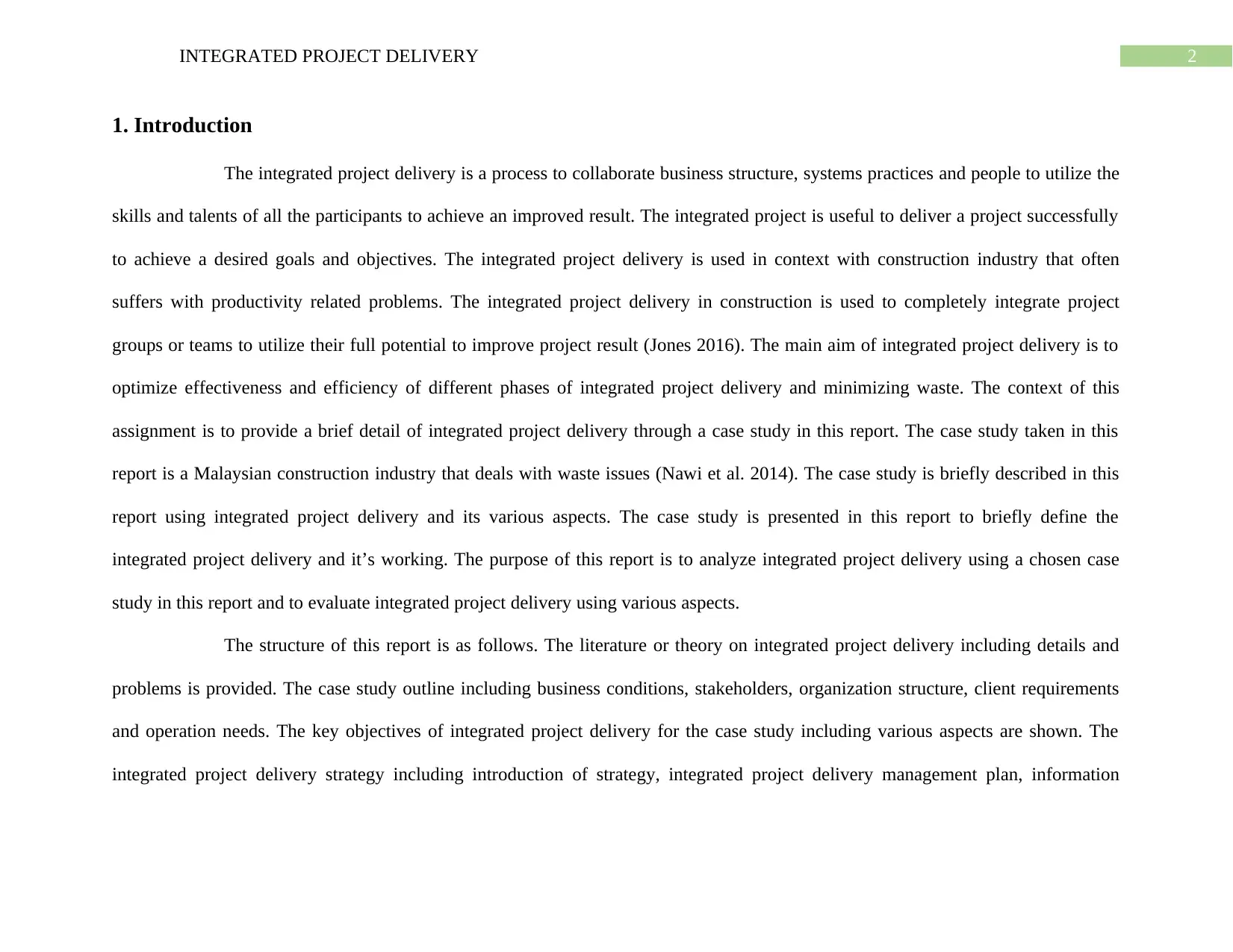
2INTEGRATED PROJECT DELIVERY
1. Introduction
The integrated project delivery is a process to collaborate business structure, systems practices and people to utilize the
skills and talents of all the participants to achieve an improved result. The integrated project is useful to deliver a project successfully
to achieve a desired goals and objectives. The integrated project delivery is used in context with construction industry that often
suffers with productivity related problems. The integrated project delivery in construction is used to completely integrate project
groups or teams to utilize their full potential to improve project result (Jones 2016). The main aim of integrated project delivery is to
optimize effectiveness and efficiency of different phases of integrated project delivery and minimizing waste. The context of this
assignment is to provide a brief detail of integrated project delivery through a case study in this report. The case study taken in this
report is a Malaysian construction industry that deals with waste issues (Nawi et al. 2014). The case study is briefly described in this
report using integrated project delivery and its various aspects. The case study is presented in this report to briefly define the
integrated project delivery and it’s working. The purpose of this report is to analyze integrated project delivery using a chosen case
study in this report and to evaluate integrated project delivery using various aspects.
The structure of this report is as follows. The literature or theory on integrated project delivery including details and
problems is provided. The case study outline including business conditions, stakeholders, organization structure, client requirements
and operation needs. The key objectives of integrated project delivery for the case study including various aspects are shown. The
integrated project delivery strategy including introduction of strategy, integrated project delivery management plan, information
1. Introduction
The integrated project delivery is a process to collaborate business structure, systems practices and people to utilize the
skills and talents of all the participants to achieve an improved result. The integrated project is useful to deliver a project successfully
to achieve a desired goals and objectives. The integrated project delivery is used in context with construction industry that often
suffers with productivity related problems. The integrated project delivery in construction is used to completely integrate project
groups or teams to utilize their full potential to improve project result (Jones 2016). The main aim of integrated project delivery is to
optimize effectiveness and efficiency of different phases of integrated project delivery and minimizing waste. The context of this
assignment is to provide a brief detail of integrated project delivery through a case study in this report. The case study taken in this
report is a Malaysian construction industry that deals with waste issues (Nawi et al. 2014). The case study is briefly described in this
report using integrated project delivery and its various aspects. The case study is presented in this report to briefly define the
integrated project delivery and it’s working. The purpose of this report is to analyze integrated project delivery using a chosen case
study in this report and to evaluate integrated project delivery using various aspects.
The structure of this report is as follows. The literature or theory on integrated project delivery including details and
problems is provided. The case study outline including business conditions, stakeholders, organization structure, client requirements
and operation needs. The key objectives of integrated project delivery for the case study including various aspects are shown. The
integrated project delivery strategy including introduction of strategy, integrated project delivery management plan, information
⊘ This is a preview!⊘
Do you want full access?
Subscribe today to unlock all pages.

Trusted by 1+ million students worldwide
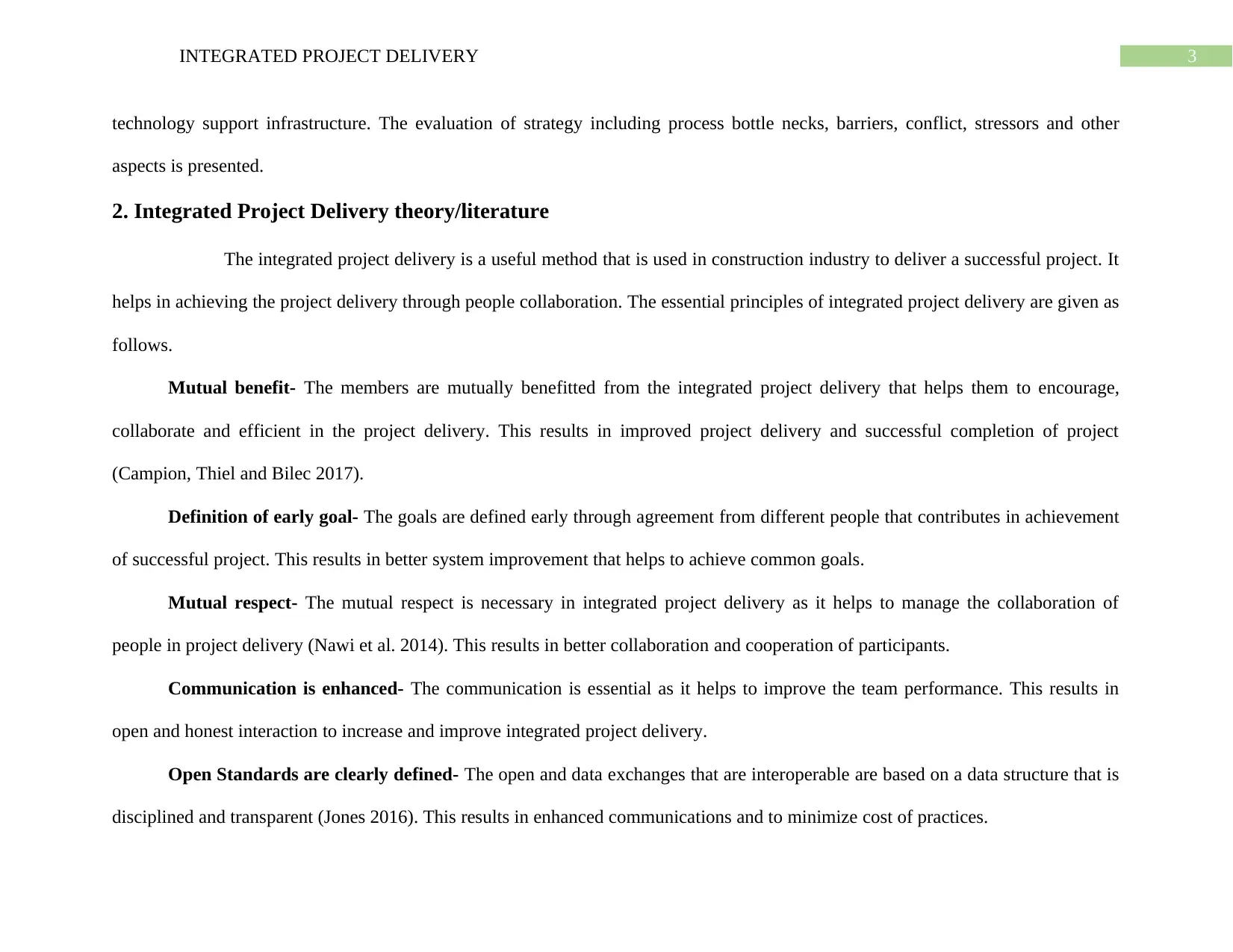
3INTEGRATED PROJECT DELIVERY
technology support infrastructure. The evaluation of strategy including process bottle necks, barriers, conflict, stressors and other
aspects is presented.
2. Integrated Project Delivery theory/literature
The integrated project delivery is a useful method that is used in construction industry to deliver a successful project. It
helps in achieving the project delivery through people collaboration. The essential principles of integrated project delivery are given as
follows.
Mutual benefit- The members are mutually benefitted from the integrated project delivery that helps them to encourage,
collaborate and efficient in the project delivery. This results in improved project delivery and successful completion of project
(Campion, Thiel and Bilec 2017).
Definition of early goal- The goals are defined early through agreement from different people that contributes in achievement
of successful project. This results in better system improvement that helps to achieve common goals.
Mutual respect- The mutual respect is necessary in integrated project delivery as it helps to manage the collaboration of
people in project delivery (Nawi et al. 2014). This results in better collaboration and cooperation of participants.
Communication is enhanced- The communication is essential as it helps to improve the team performance. This results in
open and honest interaction to increase and improve integrated project delivery.
Open Standards are clearly defined- The open and data exchanges that are interoperable are based on a data structure that is
disciplined and transparent (Jones 2016). This results in enhanced communications and to minimize cost of practices.
technology support infrastructure. The evaluation of strategy including process bottle necks, barriers, conflict, stressors and other
aspects is presented.
2. Integrated Project Delivery theory/literature
The integrated project delivery is a useful method that is used in construction industry to deliver a successful project. It
helps in achieving the project delivery through people collaboration. The essential principles of integrated project delivery are given as
follows.
Mutual benefit- The members are mutually benefitted from the integrated project delivery that helps them to encourage,
collaborate and efficient in the project delivery. This results in improved project delivery and successful completion of project
(Campion, Thiel and Bilec 2017).
Definition of early goal- The goals are defined early through agreement from different people that contributes in achievement
of successful project. This results in better system improvement that helps to achieve common goals.
Mutual respect- The mutual respect is necessary in integrated project delivery as it helps to manage the collaboration of
people in project delivery (Nawi et al. 2014). This results in better collaboration and cooperation of participants.
Communication is enhanced- The communication is essential as it helps to improve the team performance. This results in
open and honest interaction to increase and improve integrated project delivery.
Open Standards are clearly defined- The open and data exchanges that are interoperable are based on a data structure that is
disciplined and transparent (Jones 2016). This results in enhanced communications and to minimize cost of practices.
Paraphrase This Document
Need a fresh take? Get an instant paraphrase of this document with our AI Paraphraser
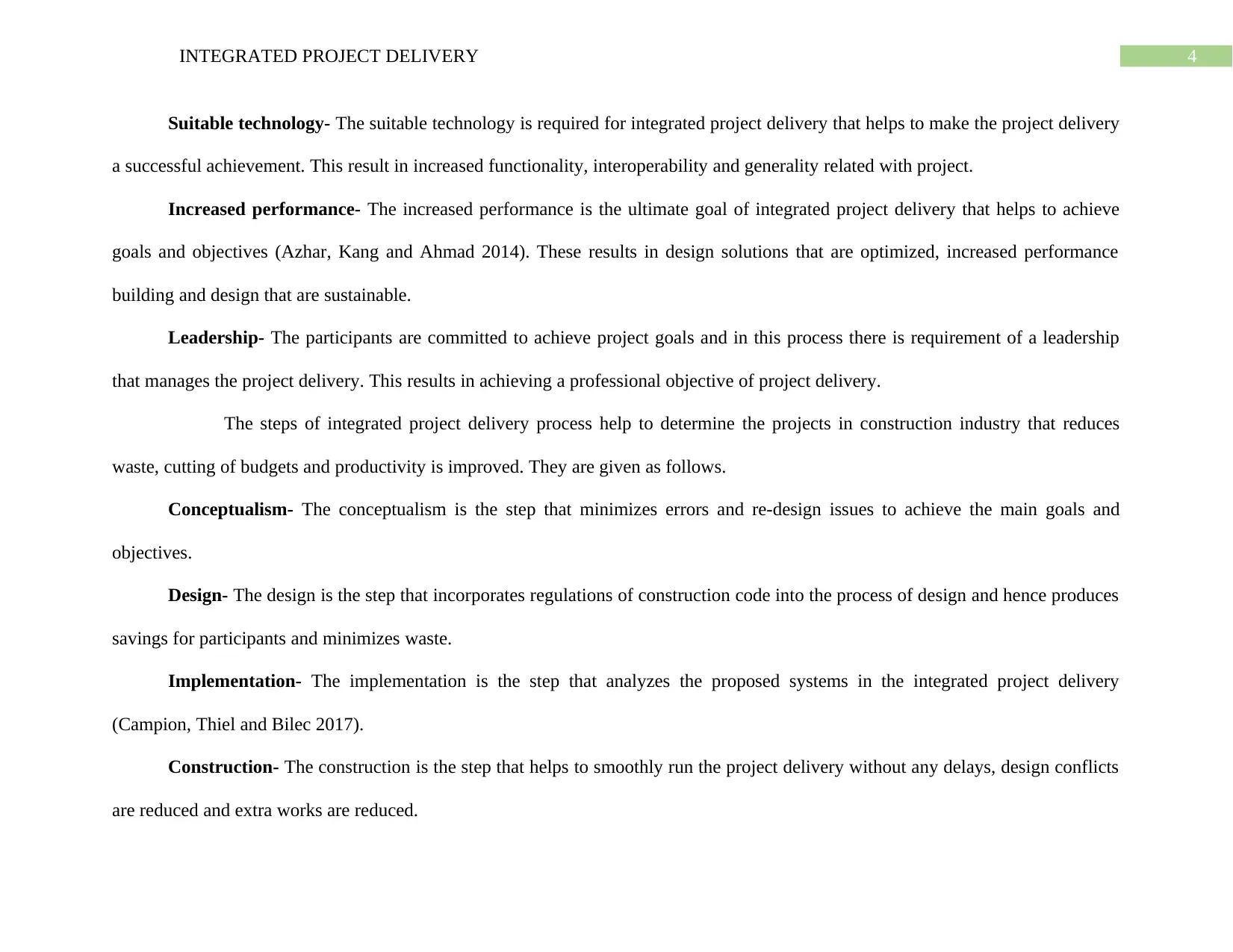
4INTEGRATED PROJECT DELIVERY
Suitable technology- The suitable technology is required for integrated project delivery that helps to make the project delivery
a successful achievement. This result in increased functionality, interoperability and generality related with project.
Increased performance- The increased performance is the ultimate goal of integrated project delivery that helps to achieve
goals and objectives (Azhar, Kang and Ahmad 2014). These results in design solutions that are optimized, increased performance
building and design that are sustainable.
Leadership- The participants are committed to achieve project goals and in this process there is requirement of a leadership
that manages the project delivery. This results in achieving a professional objective of project delivery.
The steps of integrated project delivery process help to determine the projects in construction industry that reduces
waste, cutting of budgets and productivity is improved. They are given as follows.
Conceptualism- The conceptualism is the step that minimizes errors and re-design issues to achieve the main goals and
objectives.
Design- The design is the step that incorporates regulations of construction code into the process of design and hence produces
savings for participants and minimizes waste.
Implementation- The implementation is the step that analyzes the proposed systems in the integrated project delivery
(Campion, Thiel and Bilec 2017).
Construction- The construction is the step that helps to smoothly run the project delivery without any delays, design conflicts
are reduced and extra works are reduced.
Suitable technology- The suitable technology is required for integrated project delivery that helps to make the project delivery
a successful achievement. This result in increased functionality, interoperability and generality related with project.
Increased performance- The increased performance is the ultimate goal of integrated project delivery that helps to achieve
goals and objectives (Azhar, Kang and Ahmad 2014). These results in design solutions that are optimized, increased performance
building and design that are sustainable.
Leadership- The participants are committed to achieve project goals and in this process there is requirement of a leadership
that manages the project delivery. This results in achieving a professional objective of project delivery.
The steps of integrated project delivery process help to determine the projects in construction industry that reduces
waste, cutting of budgets and productivity is improved. They are given as follows.
Conceptualism- The conceptualism is the step that minimizes errors and re-design issues to achieve the main goals and
objectives.
Design- The design is the step that incorporates regulations of construction code into the process of design and hence produces
savings for participants and minimizes waste.
Implementation- The implementation is the step that analyzes the proposed systems in the integrated project delivery
(Campion, Thiel and Bilec 2017).
Construction- The construction is the step that helps to smoothly run the project delivery without any delays, design conflicts
are reduced and extra works are reduced.

5INTEGRATED PROJECT DELIVERY
Operation- The operation is the step that reduces operational costs and maintenance costs related to integrated project
delivery.
The problems of integrated project delivery are as follows. The first challenge is integrated project delivery is not
appropriate for smaller projects. The second challenge is insurance problems where old insurance forms cannot provide what is
expected. The third challenge is legal problems that affect integrated project delivery. The fourth challenge is competitive pricing that
affects the integrated project delivery.
3. Case Study Outline
The case study chosen in this report describes Malaysian Construction of Maxis Tower, an office skyscraper in area of
Kuala Lumpur in Malaysia (Skyscrapercenter.com, 2018). This construction project helps in understanding integrated project delivery
more briefly. The Maxis tower is a 49 storey building with a height of 212m. The construction of project was done by KLCC
Properties Holdings Berhand who has also built the Petronas Twin Towers in Malaysia (En.wikipedia.org, 2018). The architect of
Maxis Tower is Roche-Dinkeloo. The construction project use integrated project delivery is used in a construction industry and the
scale on which the case study is based in large that requires larger integrated project delivery. The business environment conditions of
the Malaysian construction industry are that the industry is facing challenges associated with cost ineffectiveness and process
inefficiency (Jones 2016). The traditional processes of construction have resulted in decreased efficiency of the project in Malaysian
construction industry. The stakeholders related Maxis Tower are the engineers, architectures, other consultants, sponsor, users, project
manager, investors, trade contractors and material suppliers. The other stakeholders that are important are Malaysian Federal
Operation- The operation is the step that reduces operational costs and maintenance costs related to integrated project
delivery.
The problems of integrated project delivery are as follows. The first challenge is integrated project delivery is not
appropriate for smaller projects. The second challenge is insurance problems where old insurance forms cannot provide what is
expected. The third challenge is legal problems that affect integrated project delivery. The fourth challenge is competitive pricing that
affects the integrated project delivery.
3. Case Study Outline
The case study chosen in this report describes Malaysian Construction of Maxis Tower, an office skyscraper in area of
Kuala Lumpur in Malaysia (Skyscrapercenter.com, 2018). This construction project helps in understanding integrated project delivery
more briefly. The Maxis tower is a 49 storey building with a height of 212m. The construction of project was done by KLCC
Properties Holdings Berhand who has also built the Petronas Twin Towers in Malaysia (En.wikipedia.org, 2018). The architect of
Maxis Tower is Roche-Dinkeloo. The construction project use integrated project delivery is used in a construction industry and the
scale on which the case study is based in large that requires larger integrated project delivery. The business environment conditions of
the Malaysian construction industry are that the industry is facing challenges associated with cost ineffectiveness and process
inefficiency (Jones 2016). The traditional processes of construction have resulted in decreased efficiency of the project in Malaysian
construction industry. The stakeholders related Maxis Tower are the engineers, architectures, other consultants, sponsor, users, project
manager, investors, trade contractors and material suppliers. The other stakeholders that are important are Malaysian Federal
⊘ This is a preview!⊘
Do you want full access?
Subscribe today to unlock all pages.

Trusted by 1+ million students worldwide

6INTEGRATED PROJECT DELIVERY
Government and organization authorities. The organizational structure of the Maxis Tower construction building in Malaysian is that
there are financial department, human resources department, project department, purchasing department, engineering department and
marketing department. The organization works in a way that financial department ensures cash flow of company that leads to ensuring
sufficient funds for projects (Campion, Thiel and Bilec 2017). The human resource departments of Maxis Tower are responsible to
recruit staff and their training to benefit employee relationships and benefits of organization. The purchasing department of the
building works in way to manage purchasing of materials and resources for daily needs of company. The project department works
towards scheduling, maintaining and managing of projects that are assigned to complete the project delivery. The engineering
department works towards planning of projects through surveys, researches, analyzing and planning of projects. The marketing team
of Maxis Tower is concerned towards activities related to public relations marketing and sales. The key client requirements of the
construction industry are that they want outputs on suitable budgets and effective project with their requirements taken into accounts.
The key client requirements are better understanding of the project nature, their requirements, strong relationship between client
requirements and company’s resources. The key building operation needs cost effective resources, process technologies, capacity,
facilities, vertical integration and minimizing waste. These are the major requirements of Malaysian construction industry as per the
case study. These are the essential part in Malaysian construction industry as given in the case study that relates with dealing waste
issue in the industry and cost effectiveness (Hermann, Hermann and McGlohn 2015). Thus, the case study Maxis Tower construction
building is defined through integrated project delivery and the impact IPD on building the project.
Government and organization authorities. The organizational structure of the Maxis Tower construction building in Malaysian is that
there are financial department, human resources department, project department, purchasing department, engineering department and
marketing department. The organization works in a way that financial department ensures cash flow of company that leads to ensuring
sufficient funds for projects (Campion, Thiel and Bilec 2017). The human resource departments of Maxis Tower are responsible to
recruit staff and their training to benefit employee relationships and benefits of organization. The purchasing department of the
building works in way to manage purchasing of materials and resources for daily needs of company. The project department works
towards scheduling, maintaining and managing of projects that are assigned to complete the project delivery. The engineering
department works towards planning of projects through surveys, researches, analyzing and planning of projects. The marketing team
of Maxis Tower is concerned towards activities related to public relations marketing and sales. The key client requirements of the
construction industry are that they want outputs on suitable budgets and effective project with their requirements taken into accounts.
The key client requirements are better understanding of the project nature, their requirements, strong relationship between client
requirements and company’s resources. The key building operation needs cost effective resources, process technologies, capacity,
facilities, vertical integration and minimizing waste. These are the major requirements of Malaysian construction industry as per the
case study. These are the essential part in Malaysian construction industry as given in the case study that relates with dealing waste
issue in the industry and cost effectiveness (Hermann, Hermann and McGlohn 2015). Thus, the case study Maxis Tower construction
building is defined through integrated project delivery and the impact IPD on building the project.
Paraphrase This Document
Need a fresh take? Get an instant paraphrase of this document with our AI Paraphraser
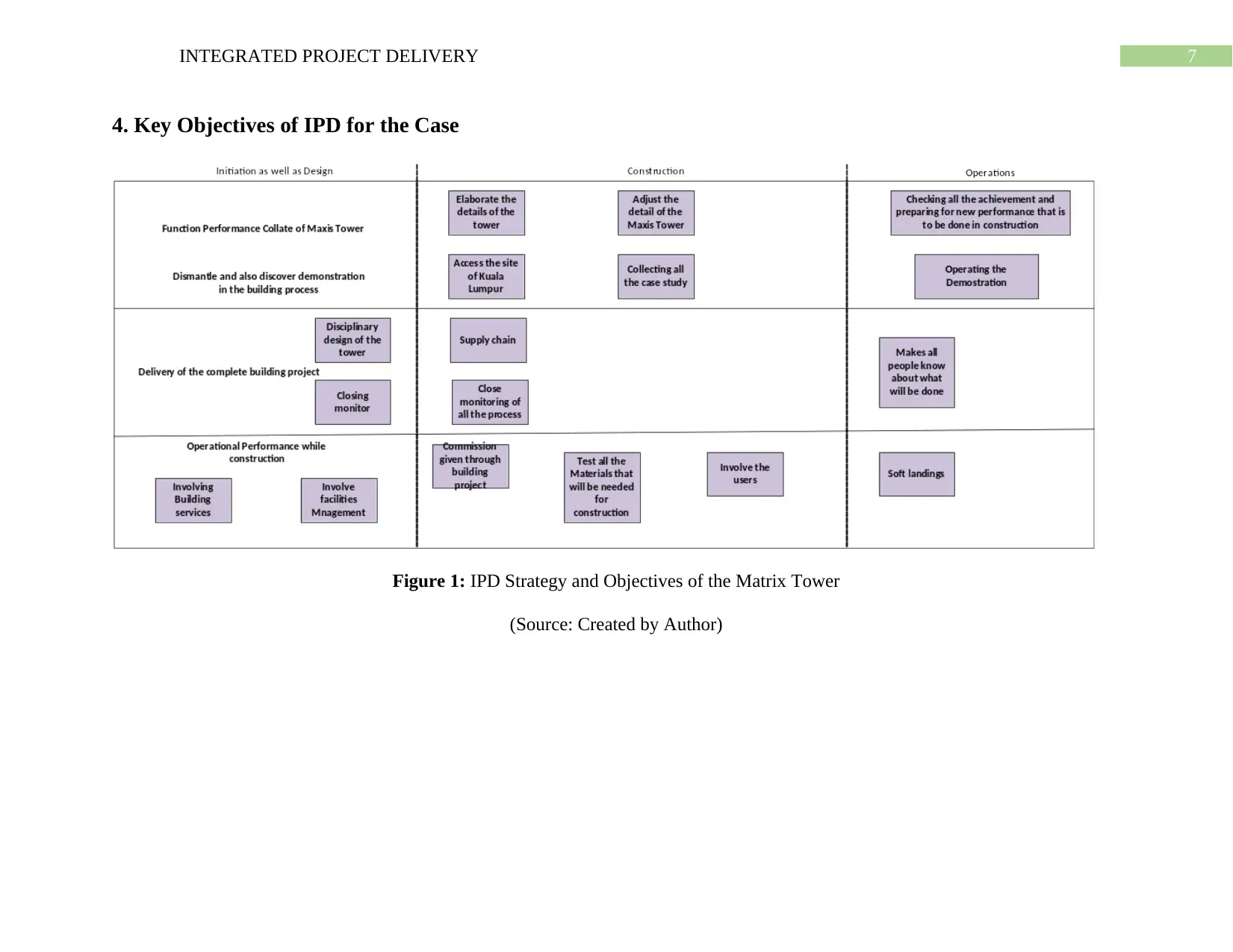
7INTEGRATED PROJECT DELIVERY
4. Key Objectives of IPD for the Case
Figure 1: IPD Strategy and Objectives of the Matrix Tower
(Source: Created by Author)
4. Key Objectives of IPD for the Case
Figure 1: IPD Strategy and Objectives of the Matrix Tower
(Source: Created by Author)

8INTEGRATED PROJECT DELIVERY
Figure 2: IPD Management of the Matrix Tower
(Source: Created by Author)
Figure 2: IPD Management of the Matrix Tower
(Source: Created by Author)
⊘ This is a preview!⊘
Do you want full access?
Subscribe today to unlock all pages.

Trusted by 1+ million students worldwide
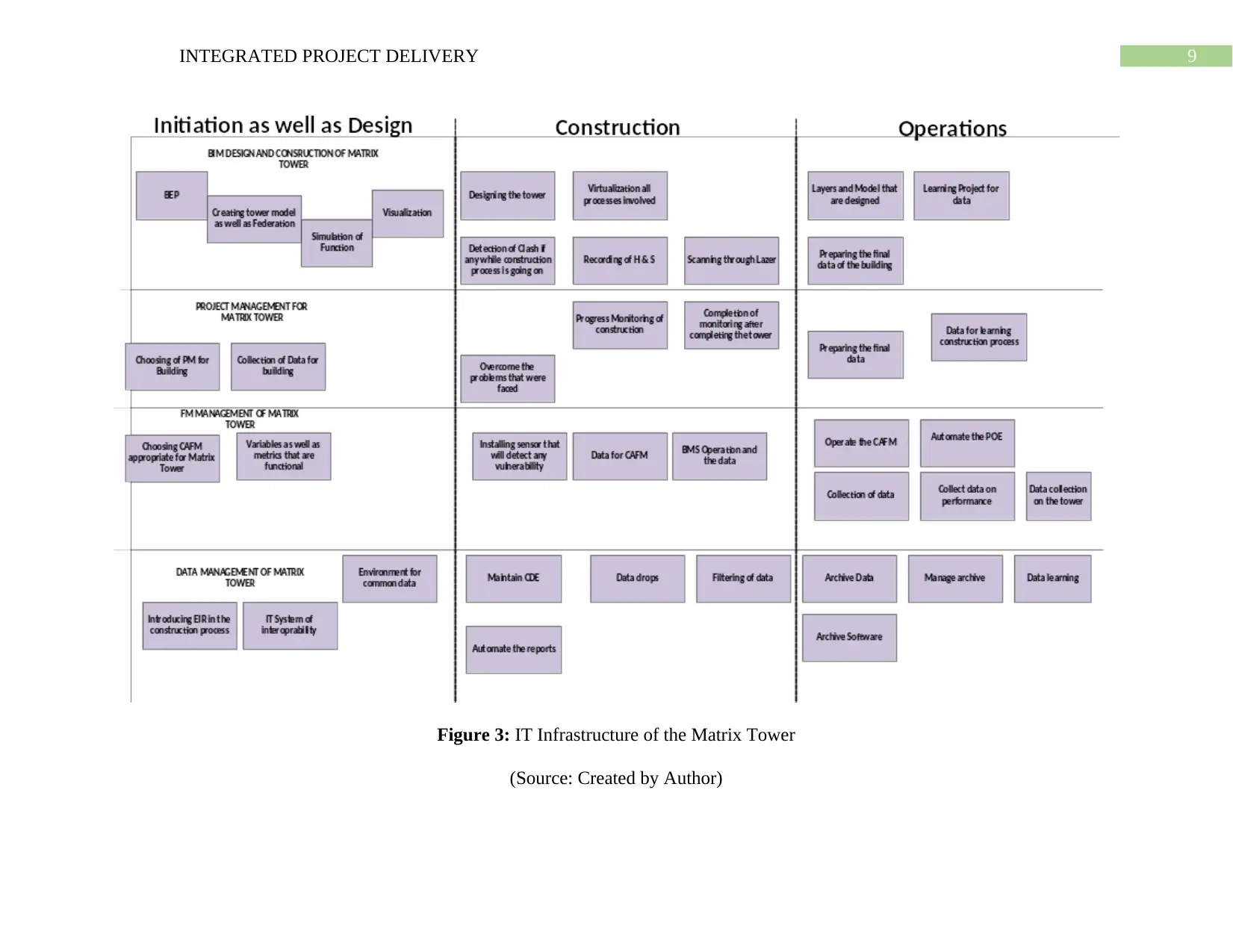
9INTEGRATED PROJECT DELIVERY
Figure 3: IT Infrastructure of the Matrix Tower
(Source: Created by Author)
Figure 3: IT Infrastructure of the Matrix Tower
(Source: Created by Author)
Paraphrase This Document
Need a fresh take? Get an instant paraphrase of this document with our AI Paraphraser

10INTEGRATED PROJECT DELIVERY
The key objectives of integrated project delivery are to minimize the construction waste and achieve cost effective project
delivery in the of the Matrix Tower construction case. The minimizing of construction waste is depicted by the process map to identify
and understand the primary flows in the integrated project delivery of Malaysian construction industry case. The focus of integrated
project delivery is to minimize the construction waste in the chosen case study. The information processes are described as
construction waste will be reduced using integrated project delivery in the given case study. The process map shows the key objectives
of integrated project delivery of the Matrix Tower Construction. The process map helps to identify the main goals and objectives of
the Matrix Tower. This will help to become the foundation for the next stages in integrated project delivery in construction. The
primary flows are physical waste of construction industry that is important in integrated project delivery for the Malaysian industry.
The phases of process map are cost overrun, time overrun, non-material and material that are important for building the Matrix Tower.
The interaction across flows shows that the construction wastes that are characterized in physical and non-physical waste must be
identified to work upon it accordingly.
5. IPD strategy
5.1 Strategy Introduction
The strategy of the integrated project delivery is to make the projects of the Matrix Tower building is cost effective and waste
is reduced. This will help in managing the construction projects (Rowlinson 2017). The integrated project delivery for Matrix Tower
building is briefly described through process maps that will help in managing the construction waste.
The key objectives of integrated project delivery are to minimize the construction waste and achieve cost effective project
delivery in the of the Matrix Tower construction case. The minimizing of construction waste is depicted by the process map to identify
and understand the primary flows in the integrated project delivery of Malaysian construction industry case. The focus of integrated
project delivery is to minimize the construction waste in the chosen case study. The information processes are described as
construction waste will be reduced using integrated project delivery in the given case study. The process map shows the key objectives
of integrated project delivery of the Matrix Tower Construction. The process map helps to identify the main goals and objectives of
the Matrix Tower. This will help to become the foundation for the next stages in integrated project delivery in construction. The
primary flows are physical waste of construction industry that is important in integrated project delivery for the Malaysian industry.
The phases of process map are cost overrun, time overrun, non-material and material that are important for building the Matrix Tower.
The interaction across flows shows that the construction wastes that are characterized in physical and non-physical waste must be
identified to work upon it accordingly.
5. IPD strategy
5.1 Strategy Introduction
The strategy of the integrated project delivery is to make the projects of the Matrix Tower building is cost effective and waste
is reduced. This will help in managing the construction projects (Rowlinson 2017). The integrated project delivery for Matrix Tower
building is briefly described through process maps that will help in managing the construction waste.

11INTEGRATED PROJECT DELIVERY
5.2 IPD Management Plan
The management structure of integrated project delivery for the given case study is described as follows.
The management structure involves management operations that includes procurement, contract, interactions and
collaborations and maintenance that also involves building and data and how to cope with the changes through training and support
activities. The management structure finally involves handling of problems and learning.
Management Operations
The management operations for given case study are described through the following aspects of the integrated project
management plan.
Procurement- The procurement process in the given case study includes five major steps and they are specification, selection,
contracting, control and measurement. The procurement process for Matrix Tower building is that specify the key participants for the
project delivery. The selection of key participants and stakeholders in minimizing the waste of construction industry (Nawi et al.
2014). The contracting is to make collaboration with the stakeholders and key participants in the project delivery. The control of
management process related to project delivery of the case study. The measurement of project delivery management that helps to
perform the system indicators that impact the effectiveness of the entire process.
Contract-The contract related with the Matrix Tower building is often referred to as integrated project delivery agreement.
The contract includes primary design of industry, primary builder and owner in the contract. As per the contract, signatories in the
given case study of Matrix Tower building are owner, lead builder and lead designer (Jones 2016). The other secondary signatories are
5.2 IPD Management Plan
The management structure of integrated project delivery for the given case study is described as follows.
The management structure involves management operations that includes procurement, contract, interactions and
collaborations and maintenance that also involves building and data and how to cope with the changes through training and support
activities. The management structure finally involves handling of problems and learning.
Management Operations
The management operations for given case study are described through the following aspects of the integrated project
management plan.
Procurement- The procurement process in the given case study includes five major steps and they are specification, selection,
contracting, control and measurement. The procurement process for Matrix Tower building is that specify the key participants for the
project delivery. The selection of key participants and stakeholders in minimizing the waste of construction industry (Nawi et al.
2014). The contracting is to make collaboration with the stakeholders and key participants in the project delivery. The control of
management process related to project delivery of the case study. The measurement of project delivery management that helps to
perform the system indicators that impact the effectiveness of the entire process.
Contract-The contract related with the Matrix Tower building is often referred to as integrated project delivery agreement.
The contract includes primary design of industry, primary builder and owner in the contract. As per the contract, signatories in the
given case study of Matrix Tower building are owner, lead builder and lead designer (Jones 2016). The other secondary signatories are
⊘ This is a preview!⊘
Do you want full access?
Subscribe today to unlock all pages.

Trusted by 1+ million students worldwide
1 out of 20
Related Documents
Your All-in-One AI-Powered Toolkit for Academic Success.
+13062052269
info@desklib.com
Available 24*7 on WhatsApp / Email
![[object Object]](/_next/static/media/star-bottom.7253800d.svg)
Unlock your academic potential
Copyright © 2020–2025 A2Z Services. All Rights Reserved. Developed and managed by ZUCOL.





